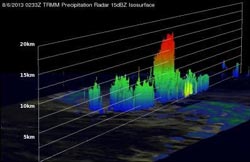NASA sees 10-mile-high thunderstorms in Hurricane Henriette

TRMM is able to measure rainfall occurring in a storm from space. Rainfall is derived from TRMM's Microwave Imager and Precipitation Radar instruments. TRMM's PR instrument measured rain falling at the rate of over 55.46 mm (~2.2 inches) per hour a towering thunderstorm near Henriette's center.<br><br>Credit: SSAI/NASA, Hal Pierce<br>
The higher the thunderstorms are, the more powerful the uplift in the air, and more powerful the thunderstorms. Thunderstorms that reach 10 miles high, like some of the ones seen in Hurricane Henriette tend to drop heavy rainfall, and NASA's Tropical Rainfall Measuring Mission or TRMM satellite confirmed that.
The TRMM satellite flew over the eastern Pacific Ocean on August 6, 2013 at 0233 UTC (~5:33 p.m. Hawaii local time) collecting data for low sun angle views of Hurricane Henriette. A visible/infrared image created by TRMM data showed shadows cast by towering thunderstorms on the northeastern side of Henriette's eye wall.
TRMM is able to measure rainfall occurring in a storm from its orbit in space. Rainfall is derived from TRMM's Microwave Imager and Precipitation Radar instruments. TRMM's PR instrument measured rain falling at the rate of over 55.46 mm (~2.2 inches) per hour a towering thunderstorm near Henriette's center.
At NASA's Goddard Space Flight Center in Greenbelt, Md. the TRMM team used the satellite's data to create 3-D images and animations. One 3-D image looking toward the east from TRMM PR data revealed that towering storms in the northeastern side of Henriette's eye were reaching heights of almost 16.75km (~10.41 miles). This kind of chimney cloud, also called a “hot tower” (as it releases a huge quantity of latent heat by condensation) can play a part in the formation or intensification of tropical cyclones. Intense rainfall in Henriette's eye wall was returning values greater than 48.7dBZ to the TRMM satellite.
At 11 a.m. EDT on Aug. 7, Hurricane Henriette's maximum sustained winds were near 85 mph/140 kph, and little change in strength is expected today, while weakening is expected to begin tomorrow, Aug. 8. The center of Hurricane Henriette was located near latitude 16.2 north and longitude 134.9 west, about 1,350 miles/2,170 km east of Hilo, Hawaii. Henriette is moving toward the west-northwest near 10 mph/17 kph and is expected to continue in that direction before turning west tomorrow, Aug. 8.
This 3-D image (looking toward the east) from TRMM PR data reveals that towering storms in the northeastern side of Henriette's eye were reaching height of almost 16.75km (~10.41 miles).
Media Contact
More Information:
http://www.nasa.govAll latest news from the category: Earth Sciences
Earth Sciences (also referred to as Geosciences), which deals with basic issues surrounding our planet, plays a vital role in the area of energy and raw materials supply.
Earth Sciences comprises subjects such as geology, geography, geological informatics, paleontology, mineralogy, petrography, crystallography, geophysics, geodesy, glaciology, cartography, photogrammetry, meteorology and seismology, early-warning systems, earthquake research and polar research.
Newest articles

Trotting robots reveal emergence of animal gait transitions
A four-legged robot trained with machine learning by EPFL researchers has learned to avoid falls by spontaneously switching between walking, trotting, and pronking – a milestone for roboticists as well…

Innovation promises to prevent power pole-top fires
Engineers in Australia have found a new way to make power-pole insulators resistant to fire and electrical sparking, promising to prevent dangerous pole-top fires and reduce blackouts. Pole-top fires pose…

Possible alternative to antibiotics produced by bacteria
Antibacterial substance from staphylococci discovered with new mechanism of action against natural competitors. Many bacteria produce substances to gain an advantage over competitors in their highly competitive natural environment. Researchers…





















